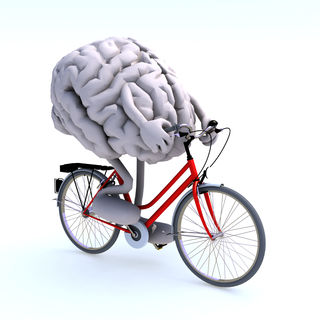Health
Bigger Brains and Higher Peak Oxygen Uptake Go Hand in Hand
Gray matter volume and cardiorespiratory fitness are linked, a new study shows.
Posted January 3, 2020 Reviewed by Devon Frye
Since the early 2000s, we've known that aerobic exercise is like "Miracle-Gro" for the brain. Countless studies over the past three decades have established that regular exercise and aerobic fitness are associated with increased gray matter volume and better white matter functional connectivity between brain regions.

New data from a five-year study (Wittfeld et al., 2020) conducted by the German Center for Neurodegenerative Diseases corroborates the association between cardiorespiratory fitness (CRF) and gray matter volume. These findings were published on January 2 in the journal Mayo Clinic Proceedings.
This study involved 2,013 participants (21 to 84 years old) from northeastern Germany. Study participants' CRF was tracked between 2008 and 2012. The key measurement used to gauge fitness was peak oxygen uptake (VO2 peak) while pedaling at various intensities on a stationary exercise bike.
Magnetic resonance imaging (MRI) was used to monitor changes in gray matter volume based on the size of specific brain regions throughout the five-year study.
Katharina Wittfeld describes her latest research in this YouTube video: "Cardiorespiratory Fitness and Gray Matter Volume."
Notably, the researchers found a strong association between higher peak oxygen uptake and more gray matter volume in areas of the cerebrum and increased cerebellum (Latin for "little brain") size. Bigger brains and better fitness were also associated with slower age-related cognitive decline.
The authors sum up their findings:
"Cardiorespiratory fitness was positively associated with gray matter volume, total brain volume, and specific gray matter and white matter clusters in brain areas not primarily involved in movement processing. The results of this study support the hypothesis that higher CRF is associated with larger brain volumes in several brain regions that are not primarily connected to motor-related functions."
An accompanying editorial, "Cardiorespiratory Fitness and Brain Volumes," was also published in the January 2020 issue of Mayo Clinic Proceedings.
The three authors of this editorial—Ronald Petersen, Michael Joyner, and Clifford Jack, Jr.—describe the latest findings (2020) from Katharina Wittfeld and colleagues as an "encouraging" and "intriguing" contribution to "the growing literature relating to exercise and brain health."
Petersen is a Mayo Clinic neurologist and first author of the editorial. In a news release, he said this research "provides indirect evidence that aerobic exercise can have a positive impact on cognitive function in addition to physical conditioning."
"This is another piece of the puzzle showing physical activity and physical fitness is protective against aging-related cognitive decline," Michael Joyner, who is a Mayo Clinic anesthesiologist and physiologist, added. "There's already good epidemiological evidence for this, as well as emerging data showing that physical activity and fitness are associated with improved brain blood vessel function. This paper is important because of the volumetric data showing an effect on brain structure."
That said, this "CRF and Brain Volume" editorial cautions against over-interpreting the data and automatically assuming a causal relationship between aerobic exercise and increased gray matter volume. Correlation does not imply causation, and these findings are correlative.
In their editorial, Petersen, Joyner, and Jack conclude, "Very-long-term studies on topics related to an exercise intervention and brain health will be costly and logistically challenging to conduct." Nevertheless, they point out that the latest correlative findings (2020) on an association between CRF and gray matter volume in certain brain structures are "unique."
Mayo Clinic experts (and the Office of Disease Prevention and Health Promotion) recommend at least 150 minutes per week (e.g., 30 minutes, five days a week) of moderate-to-vigorous physical activity (MVPA) to maintain cardiorespiratory fitness.
Related Posts:
References
Katharina Wittfeld, Carmen Jochem, Marcus Dörr, Ulf Schminke, Sven Gläser, Martin Bahls, Marcello R.P. Markus, Stephan B. Felix, Michael F. Leitzmann, Ralf Ewert, Robin Bülow, Henry Völzke, Deborah Janowitz, Sebastian E. Baumeister, Hans Jörgen Grabe. "Cardiorespiratory Fitness and Gray Matter Volume in the Temporal, Frontal, and Cerebellar Regions in the General Population." Mayo Clinic Proceedings (First published: January 2, 2020) DOI: 10.1016/j.mayocp.2019.05.030
Ronald C. Petersen, Michael J. Joyner, Clifford R. Jack, Jr. An Editorial: "Cardiorespiratory Fitness and Brain Volumes." Mayo Clinic Proceedings (First published: January 2, 2020) DOI: 10.1016/j.mayocp.2019.11.011


